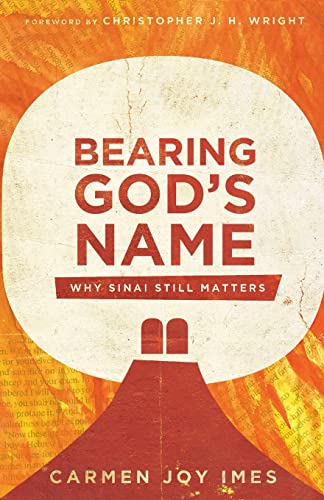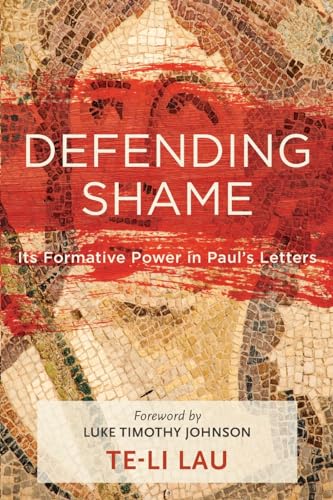Bearing God’s Name: Why Sinai Still Matters
Written by Carmen Joy Imes Reviewed By John F. KlemBearing God’s Name, Why Sinai Still Matters is Carmen Joy Imes’s Wheaton PhD dissertation made accessible for popular use. The more technical presentation is Bearing YHWH’s Name at Sinai: A Reexamination of the Name Command of the Decalogue, Bulletin for Biblical Research Supplement 19 (University Park, PA: Eisenbrauns, 2018).
In this book Imes explains the importance and ongoing relevance of Sinai in a two-part format. Her goal is to demonstrate the Christian’s need of the Old Testament by examining the name command in Exodus 20:7 (p. 5). Her approach includes a visit to Mount Sinai for a guided tour of the law strategically placed in the larger context of fifty-seven chapters between the wilderness stories in Exodus and Numbers (pp. 13–15). The law is for Israel after deliverance from Egypt, who now has a new identity and vocation as the people of God (pp. 5, 16–18). The wilderness journey from Egypt to Canaan, according to Imes, is a liminal space for growth and transformation (pp. 16–18). In chapters 6–10, Imes traces the responsibility of name bearing in the history of Israel’s covenant relationship, through the life and ministry of Christ, and then into the life of the church. Imes’s tour incorporates a number of Sidebar Notes to clarify and demystify key Old Testament themes.
Imes’s working thesis is that the name command of Exodus 20:7 and Deuteronomy 5:11 is not limited to some type of blasphemous, unholy speech act. Rather, it involves carrying the divine name in a representational and ethical manner. God’s people, who are branded or tattooed with his name, must bear it obediently and faithfully in every area of life (pp. 48–52).
Chapter 3 is where Imes presents the essence of the name command. Based on grammar and a chiastic structure, Imes includes the preamble (Exod 20:1–2) and the prohibitions against other gods and idol making as the first command (pp. 47–48). The second is the name command in Exodus 20:7. The ten commands embedded in a narrative function as authoritative guidance, law as wisdom instead of civil legislation (pp. 37–38, 44–45).
Imes challenges popular approaches to Exodus 20:7 with intertextual work that yields a different metric. She translates the command, “You must not bear (or carry) the name of Yahweh, your God, in vain, for Yahweh will not hold guiltless one who bears (or carries) his name in vain” (p. 49). Imes then looks to the High Priestly garments described in Exodus 28 for a representational and ethical understanding of the command’s intent (pp. 49–51). The High Priestly garments, the Holy, belonging to Yahweh, inscription on the front of the priest’s turban, and his work of bearing or carrying the names of the sons of Israel as he moves around the tabernacle illuminates the name command. In Exodus 19 the LORD bestowed on his people the titles of treasured possession, kingdom of priests, and holy nation (p. 31). Their vocation was to represent God to the rest of humanity. They were to function in priestly ways by mediating between Yahweh and everyone else. As such, they carry forward, bear the name of Yahweh (Exod 6:7). Thus, the first two commands are the weightiest and set the stage for the rest of the commands that address every area of life (work, family, conflict, marriage, property, reputation). God’s glory is diminished when Yahweh’s name is carried forward by worshipping other gods or by disobeying God’s law. Misusing the name of the Lord, therefore, involves more than not swearing.
A crucial part of Imes’s argument for the relevance of Sinai today is the interpretation of Jeremiah 31 as a renewed, refreshed covenant instead of something completely new (pp. 129–31). After focusing on the similarities between Sinai and Jeremiah 31, she concludes that the difference between the two is the mode of delivery. God offers Israel a new forgiveness opportunity that is more permanent, transformative, and internalized. Imes views the new covenant as similar to the new mercies of Lamentations 3:23. When interpreting Hebrews 8:13, she posits that the administration of the covenant (temple, priests, and sacrifices) is temporary and passing (pp. 130–31, 160–61). Although Imes comments on the Sermon on the Mount, more balanced attention to Christ’s fulfillment of the law would enhance the argument (pp. 142–43).
Imes exposits the name command very persuasively. Her writing style and appropriate use of personal illustrations solidify rather than distract. The appendices along with the list of Bible Project resources, QR codes, and discussion questions encourage more study.
Imes’s work is a positive contribution to the field of biblical theology that aligns with the missional drama approach, similar to the works of Bartholomew and Goheen (pp. ix–xiii). Her development of the name command further elucidates the themes of mission and ethics in both testaments (p. 30). Imes’s methodology is good example of a literary, historical, theological investigation along with excellent intertextual study.
Imes’s hermeneutical presuppositions will stimulate debate. The goal to show the relevance of Sinai for the church is framed within a Reformed view of gospel-law continuity (p. 161, 180–82). Her approach emphasizes Christ’s work to clarify rather than to fulfill the law. For Imes, the Ten Commandments continue to have relevance today, while the laws that separate Israel as an ethnic group have been “set aside” (p. 182). The weighty topics of covenants (pp. 61, 131), law (pp. 36–37), and Israel-Church relationship (p. 182) are presented in a summative manner and with uneven supporting reference. Class notes, for example, are cited for the meaning of Passover (p. 13). The book would benefit from footnotes and sidebars that acknowledge presuppositions and offer alternative views. Something like the “How Many Hebrews?” sidebar (pp. 90–91). Tracing a theme often runs the risk of flattening contexts and ignoring others. In this study, little attention is given to the book of Judges (pp. 109–11), in which significant name command violation is documented.
In all fairness, the nature of the publication and the intended audience influence Imes’s approach. Regardless, the main thesis of the name command to worship the Lord exclusively and to represent him well can tolerate differences of opinion related to each topic. The weight of the command is not diminished for the New Testament believer nor is the vital relationship between mission and ethics.
John F. Klem
John F. Klem
Regent University
Virginia Beach, Virginia, USA
Other Articles in this Issue
The concept of personhood is crucial for our understanding of what it is to be human...
Text-Criticism and the Pulpit: Should One Preach About the Woman Caught in Adultery?
by Timothy E. MillerThis article considers whether “The Woman Caught in Adultery” (John 7:53–8:11) should be preached...
Celebration and Betrayal: Martin Luther King’s Case for Racial Justice and Our Current Dilemma
by James S. SpiegelDuring the American Civil Rights Movement, Martin Luther King’s principal arguments reasoned from theological ethics, appealing to natural law, imago Dei, and agape love...
Many churches switched to streaming or recording their services during the COVID-19 crisis...







